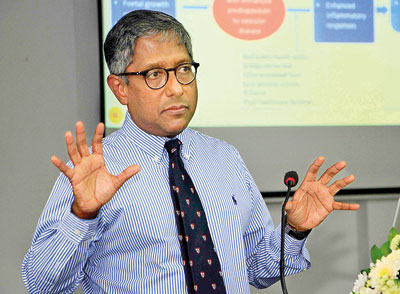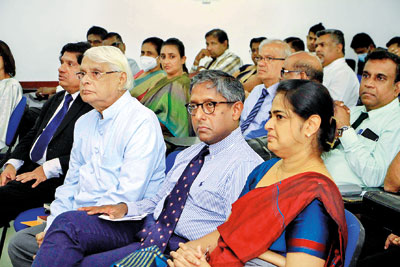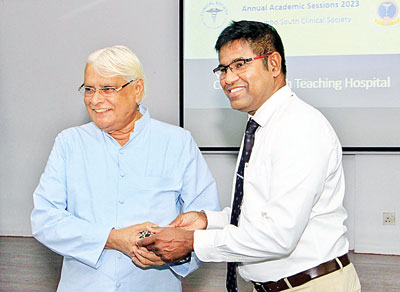News
Twin evils of poverty and poor health
View(s):- Chilling disclosure of ‘health following a social gradient’ by expert at CSTH’s Clinical Society sessions
By Kumudini Hettiarachchi
What the hundreds of people seeking treatment and care here did not know was that up on the 7th floor in the Dr. W.G. Gunawardene Auditorium of the Surgery Building Complex, senior and junior doctors were gathered to share knowledge to serve patients better.
Friday’s one-day Annual Academic Sessions 2023 of the Clinical Society of the CSTH included three important plenaries, poster presentations and free paper sessions, with the inauguration being attended by hospital Director Dr. Sagari Kiriwandeniya who is the Patron of the society. The sessions were kicked off by a dance performance by the medical students of the Faculty of Medical Sciences, University of Sri Jayewardenepura. The Clinical Society also launched its website that morning.

Dr. Asoka Gunaratne addressing the gathering. Pix by Indika Handuwala
Pointing out that these sessions were the most important event on their calendar, the President of the Clinical Society, Dr. Asoka Gunaratne said that there has been no smooth sailing for the society but a bumpy ride. However, it has striven to keep its members informed about the latest developments in the field of medicine. The sessions also provided a platform for juniors to present their research and audits.
“Health follows a social gradient,” was what Chief Guest Prof. Asita de Silva who is Senior Professor of Pharmacology, Faculty of Medicine, University of Kelaniya, succinctly and powerfully proved, quoting several studies in the United Kingdom (UK), the United States of America (USA) and also worldwide, before looking at the “sad” situation in Sri Lanka. He was speaking on ‘Social inequality and impact of the economic crisis on non-communicable diseases (NCDs)’.
A well-known ‘clinical trialist’ (one who conducts clinical trials to come up with scientific data and conclusions), Prof. de Silva dived into extensive studies carried out by eminent Professor Sir Michael Marmot of University College London, UK, who has authored ‘The Health Gap: The Challenge of an Unequal World’.
The study ‘Life expectancy and disability-free life expectancy at birth by neighbourhood income deprivation, 2009-2013’ had shown that the gradient was steeper for those with lower incomes. They had eight fewer years of healthy life than the affluent. Similar trends had been observed in a study done in Baltimore, USA, while this pattern had also been seen in other research such as ‘Five continent meta-analysis’ and ‘Global Burden of Disease 2019: Leading risk factors for death in 204 countries’.
Citing another study on ‘Cardio-metabolic disease – life course considerations’, Prof. de Silva said that it revealed that prolonged deprivation & starvation; maternal malnutrition; foetal growth retardation; and lower birth weight resulted in a phenotype with enhanced predisposition to vascular disease. There was an epigenetic alteration in the DNA sequence. Then with factors such as bad public health policy, an energy-dense diet, ultra-processed food, low physical activity, tobacco and poor healthcare facilities, the obvious occurred – weight gain, raised blood pressure, insulin resistance, diabetes and enhanced inflammatory response which, in turn, led to the early onset of cardiovascular disease (CVD) and reduced life expectancy and disability-free life expectancy.
The Baltimore study had found that while there was a life expectancy of 82 years for people in the study area, the socially-deprived in the same area had only up to 62 years.

Prof. Asita de Silva making his presentation
The ‘Five continent meta-analysis’, meanwhile, had found that though the CVD risk was higher in high-income (rich) countries, lesser in middle-income countries and lowest in low-income countries, the event of a myocardial infarction (MI or heart attack) was lowest in the high-income countries and highest in the low-income countries. This was because there were mitigating strategies in high-income countries.
Underscoring that social inequities affect healthcare, Prof. de Silva next zeroed in on hypertension (high blood pressure), the “biggest” killer in low and middle income countries.
While an Oxford study in its 18th year now has found that lower the blood pressure, lower the threat, he focused on “barriers” to hypertension care:
On the part of the patient – inadequate access to hypertension care; poor awareness; out-of-pocket cost for medication; and poor adherence to healthy lifestyle and medications.
On the part of the healthcare provider – lack of knowledge about hypertension care; clinical inertia in up-titrating prescriptions (increasing the dose) when necessary; time constraints on busy practices; and poor communication.
On the part of the health system – lack of trained health professionals; lack of standardized care/coordination; poor access to anti-hypertensives (procurement/stock); poor blood pressure screening; weak IT support; distance to clinics and poor outreach.
Referring to Sri Lanka’s very own study with himself as the Principal Investigator under the multi-country ‘Control of Blood Pressure and Risk Attenuation – Bangladesh, Pakistan, Sri Lanka’ (COBRA-BPS) in rural Puttalam, Prof. de Silva said that it was a multi-component intervention for hypertension care, focusing around proactive visits by trained community healthcare workers through the existing primary healthcare system and drug therapy.
The results were significant – blood pressure had been controlled in 53.2% in the intervention group among the 2,500+ participants, compared to 43.7% in the control group.
“We piggy-backed on the existing primary healthcare system and the multi-component intervention was ‘massively’ effective,” he added.
Meanwhile, the sessions’ plenaries were: ‘Poverty complicating acute coronary syndrome – managing with minimum resources’ by CSTH’s Consultant Cardiologist Dr. Chandrike Ponnamperuma; ‘Fussy eater – when, why and how to handle?’ by Prof. Ruwanthi Perera of the Faculty of Medical Sciences, University of Sri Jayewardenepura; and ‘Remission of diabetes’ by CSTH’s Consultant Endocrinologist Dr. Niranjala Meegodawidanege.

CSTH Director Dr. Sagari Kiriwandeniya (far right), Prof. Asita de Silva and Emeritus Prof. J.B. Disanayake at the sessions
| ‘Patients paying more than double for meds – if unaddressed could be catastrophic’ ‘Out-of-pocket’ expenditure from households (private sector) accounts for more than 50% of the total value of current health expenditure, while ‘out-of-pocket’ expenditure to access medicine was 34% of the average-household expenditure on health, said Prof. Asita de Silva, getting onto a different but important topic for Sri Lankans. This former Chairperson of the National Medicines Regulatory Authority (NMRA), analysed costs for a standard prescription for diabetes and high blood pressure for a single patient. In 2019-2020 the medications which cost Rs. 2,557.50 per month were now (same medications and same quantities) Rs. 5,679.00, more than double, he said. “If this issue goes unaddressed, the results would be ‘catastrophic’,” added Prof. de Silva, reiterating that “health follows a social gradient”. | |
| All about Sinhala  The President-elect of the Clinical Society, Dr. Yasas Abeywickrama presenting a token to Emeritus Prof. J.B. Disanayake Leaving medicine behind and speaking on ‘The evolution of Sinhala’, Guest-of-Honour Emeritus Prof. J.B. Disanayake had the audience in stitches with his presentation being liberally laced with humour. Jokes apart, he said language is like an amoeba (unicellular organism) which splits into two – Bengali splitting into two resulting in the mother language of Bengali and daughter language of Sinhala. Similarly, Sinhala splitting into two resulting in Sinhala and the Maldivian language of Dhivehi bas. According to this Sinhala scholar, language changes in three ways – by dropping (like a snake shedding its skin) or adding and due to functional changes (like a girl reaching puberty and becoming a woman). However, it is the same language. After dealing with the influence of Portuguese, Dutch and English on Sinhala, he described how Sinhala did not have the ‘f’ sound and the need to create two vowels (to pronounce such words as Ernst and colonel), otherwise how would one say: ‘Much ado about nothing’. Prof. Disanayake was proud that there was a Sinhala real-time Unicode and that the Sinhala alphabet was the “most creative” with four sannaka and two vowels ae and ae: “I can teach any foreigner Sinhala in one minute,” he said tongue-in-cheek, adding that one just had to affix ‘eka’ or ‘kenek’ to a noun (computer-eka/car-eka or doctor-kenek) and karanawa to a verb (present-karanawa, type-karanawa). Moving away from humour, he sent out an earnest appeal to doctors: “Keep your status as doctors because you deal with the lives of others.”
|
The best way to say that you found the home of your dreams is by finding it on Hitad.lk. We have listings for apartments for sale or rent in Sri Lanka, no matter what locale you're looking for! Whether you live in Colombo, Galle, Kandy, Matara, Jaffna and more - we've got them all!

